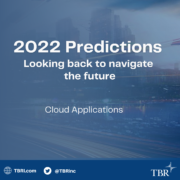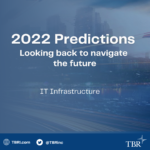How has economic uncertainty impacted the cloud applications market in 2022?
Cloud applications vendors benefited from the disruptions that the pandemic wrought upon enterprises since the initial outbreak, as organizations embraced remote workforces enabled by cloud technologies to maintain business continuity. This trend resulted in a rapid modernization of enterprise IT estates, which guided TBR’s 2022 predictions for the cloud applications market.
Now, well into 2H22, cloud applications vendors are pursing growth amid mounting economic uncertainty ranging from inflation challenges to geopolitical concerns — headwinds that are set to linger well into 2023.
Prediction No. 1: SaaS opportunity size attracts all kinds of new participants
Senior Analyst Evan Woollacott: When looking at 2022, TBR estimated the SaaS market opportunity would reach $225 billion and continue to grow at a rate of more than 10% year-to-year as a confluence of trends ranging from client need for application customization and SaaS vendors’ pursuit of industry outcomes creates new growth opportunities.
Small startup ISVs are the most logical players to be attracted to the opportunity, and the number of these new companies coming to market has continued to grow, even during the pandemic. Through 1H22, multiple legacy software incumbents recognized the shortcomings of traditional partner programs and sought to simplify the programs to encourage cloud ecosystem development.
For instance, during an interview in March, SAP’s SVP of Software Partner Solutions Tom Roberts outlined the company’s plans to adjust fees for partners to join SAP’s Online Marketplace and integrate with SAP systems. SAP plans to waive the traditional 15% fee for the majority of partners that join the Online Marketplace, reducing barriers to entry for niche ISVs that may be wary of the upfront costs. Further, SAP will reportedly reduce the fee partners pay to connect with these systems from 20% of revenue to 15%.
Enabling partner coinnovation, though, will require SaaS vendors to not only offer partner-friendly program constructs but also possess the necessary PaaS capabilities to allow partners to seamlessly integrate their IP within vendor portfolios to accelerate joint time to market. The availability of these assets, together with program benefits like joint S&M funds, will be crucial points of differentiation for SaaS vendors aiming to encourage ISV community engagement in a highly contested marketplace.
Prediction No. 2: Cloud delivery for mission-critical applications inches closer to mainstream
Evan: The overall applications market witnessed a landmark event in 2022, as TBR’s 1Q22 Cloud and Software Applications Benchmark found that Salesforce eclipsed SAP as the largest applications vendor in terms of total revenue, despite Salesforce lacking on-premises application revenue. This event speaks to the level of client adoption maturity for front-office workloads, like S&M and CRM, compared to that of back-office functions like ERP.
Salesforce’s evolution to a SaaS incumbent has been impressive, and the company has increasingly sought to sustain its performance by establishing relevancy outside front-office workloads with solutions like Revenue Cloud, a revenue lifecycle management offering. These portfolio expansion efforts are well timed, as TBR’s 1H22 Cloud Applications Customer Research indicates client willingness to migrate mission-critical applications to cloud is rising, setting the stage for workloads outside the front office to catalyze the next wave of growth for the cloud applications market.
Specifically, TBR’s 1Q22 Cloud and Software Applications Benchmark also found that Business Applications (BA) workloads, which includes applications like ERP, finance and payroll, had the highest mix of benchmarked on-premises revenue at 37% of the 1Q22 BA revenue total, compared to just 11% for benchmarked Sales & Marketing revenue. This represents a vast install base of legacy BA clients to migrate to SaaS offerings, be it SAP’s Business Suite 4 HANA (S/4HANA) or Oracle’s Fusion ERP.
While ERP incumbents like SAP have reported promising backlog growth for SaaS ERP portfolios, converting this opportunity to revenue will require greater involvement of the IT services and consulting ecosystem to mitigate migration complexity associated with workloads like ERP. Application vendors must provide, with partner support, efficient, seamless migrations for mission-critical workloads, particularly given mounting economic uncertainty, which has already resulted in greater IT budget scrutiny across all workloads, evidenced by statements made by Salesforce executives during the company’s 2Q22 earnings call.
Prediction No. 3: Customization becomes the standard for cloud applications
Evan: A confluence of trends guided TBR’s prediction that customization for cloud applications would become table stakes in 2022. This belief has only been strengthened over the past nine months as a litany of predicted indicators materialized, ranging from platform investments to support citizen developers to the accelerated expansion of industry-led portfolios.
At the platform level, vendors like Microsoft and Salesforce have sought to bolster the scope of their PaaS suites. While data integration and management capabilities remain vital to vendors’ multiproduct sales efforts, these same assets also support the inclusion of partners’ technologies alongside their core IP. Likewise, vendor investment has accelerated around self-service developer capabilities and robotic process automation (RPA) assets to provide maturing customers with tool kits to get more out of their deployed SaaS workloads, customizing them according to their specific business processes.
Lastly, supporting clients’ growing appetite for industry customization remains a top investment priority for application vendors, particularly in the healthcare space, where the impact of the pandemic resulted in a rapid shift in how healthcare entities provide services, perhaps best characterized by a surge in the use of telehealth to reduce medical workers’ risk of exposure.
Highlighting vendor efforts, Oracle completed its $28.3 billion acquisition of Cerner in June 2022, immediately outlining plans to enhance Cerner’s core health management system, Millennium, through many new features and improvements, including a voice-enabled user interface and an IoT network for diagnostic devices. Oracle is already starting to verticalize Fusion, announcing Oracle Fusion HCM and ERP for Healthcare, which will incorporate industry-specific rules based on inputs pulled from Cerner and then tied back into HR and financial records within Fusion.
Predictions is an annual TBR series examining market trends and business changes in key markets. 2022 covered segments included cloud, telecom, devices, data center, and services & digital.

 Technology Business Research, Inc.
Technology Business Research, Inc.
 Technology Business Research, Inc.
Technology Business Research, Inc.